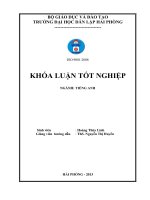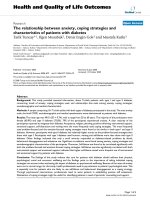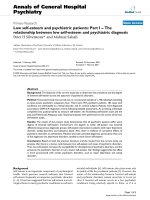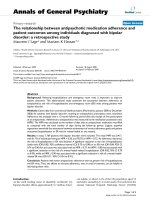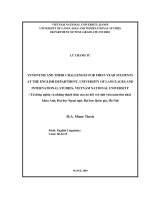THE RELATIONSHIP BETWEEN LANGUAGE LEARNING STRATEGIES AND ENGLISH PROFICIENCY OF 4TH YEAR STUDENTS AT FELTE,ULIS, VNU
Bạn đang xem bản rút gọn của tài liệu. Xem và tải ngay bản đầy đủ của tài liệu tại đây (1.43 MB, 91 trang )
VIETNAM NATIONAL UNIVERSITY, HANOI
UNIVERSITY OF LANGUAGES AND INTERNATIONAL STUDIES
FACULTY OF POST-GRADUATE STUDIES
ĐOÀN THỊ THU PHƢƠNG
THE RELATIONSHIP BETWEEN LANGUAGE
LEARNING STRATEGIES AND ENGLISH
PROFICIENCY OF 4
TH
YEAR STUDENTS AT FELTE,
ULIS, VNU
Mô
́
i quan hê
̣
giƣ
̃
a chiê
́
n lƣơ
̣
c ho
̣
c tâ
̣
p ngôn ngƣ
̃
va
̀
trình độ
tiếng Anh của sinh viên năm thứ 4 khoa Sƣ Phạm Tiếng
Anh, trƣờng Đại học Ngoại Ngữ - ĐHQGHN
M.A. COMBINED PROGRAMME THESIS
Major:
English Teaching Methodology
Major code:
60 14 10
Hanoi - 2012
VIETNAM NATIONAL UNIVERSITY, HANOI
UNIVERSITY OF LANGUAGES AND INTERNATIONAL STUDIES
FACULTY OF POST-GRADUATE STUDIES
ĐOÀN THỊ THU PHƢƠNG
THE RELATIONSHIP BETWEEN LANGUAGE
LEARNING STRATEGIES AND ENGLISH
PROFICIENCY OF 4
TH
YEAR STUDENTS AT FELTE,
ULIS, VNU
Mô
́
i quan hê
̣
giƣ
̃
a chiê
́
n lƣơ
̣
c ho
̣
c tâ
̣
p ngôn ngƣ
̃
va
̀
trình độ
tiếng Anh của sinh viên năm thứ 4 khoa Sƣ Phạm Tiếng
Anh, trƣờng Đại học Ngoại Ngữ - ĐHQGHN
M.A. COMBINED PROGRAMME THESIS
Major:
English Teaching Methodology
Major code:
60 14 10
Supervisor:
Dr. Đỗ Tuấn Minh
Hanoi - 2012
iv
TABLE OF CONTENTS
PAGE
Declaration i
Acknowledgement ii
Abstract iii
List of tables and figures iv
List of abbreviations/ acronyms vi
CHAPTER 1: INTRODUCTION
1.1. Statement of the problem and rationale for the study 1
1.2. Aims and objectives of the study 4
1.3. Scope of the study 5
1.4. Organization of the study 5
CHAPTER 2: LITERATURE REVIEW
2.1. Learning strategies 7
2.1.1. Definition of learning strategies 7
2.1.2. Classification of learning strategies 10
2.2. Language Proficiency 18
2.2.1. Definition of language proficiency 18
2.2.2. The Common European Framework of Reference for Languages 20
2.3. Language learning strategies and English proficiency 24
CHAPTER 3: METHODOLOGY
3.1. Selections of subjects 28
3.2. Data collection instruments 28
3.2.1. Ielts Test 29
v
3.2.2. Questionnaires 29
3.2.3. Interviews 31
3.3. Procedures of data collection 32
3.4. Procedures of data analysis 34
CHAPTER 4: RESULTS AND DISCUSSION
4.1. Frequency of language learning strategy use 36
4.2. The correlation between students‟ language learning strategies and their
English proficiency 46
4.3. Key strategies and potential factors affecting strategy use 48
CHAPTER 5: CONCLUSION
5.1. Major findings of the study 69
5.2. Contributions of the study 71
5.3. Limitations of the study 72
5.3. Suggestions for further research 73
REFERENCES 74
APPENDICES I
1
LIST OF TABLES AND FIGURES
PAGE
Table 2.1. Classification of learning strategies (1975-1985) (Olga, 2003, p.7) 12
Table 2.2. Classification of strategies (1983 – 1991) (Olga, 2003, p.13) 15
Table 2.3. A Comparison of Rubin‟s and Oxford‟s Strategy Classification
Systems (cited in Hsiao & Oxford, 2002, p.170) 17
Table 2.4. The Common European Framework of Reference for Languages
(CEFR) 21
Table 2.5. Common Reference Levels: global scale. 22
Table 4.1. Average reported frequency of language learning strategy use by both
groups of students. 36
Table 4.2. Average reported frequency of language learning strategy use for the
basic group, the proficient group and both groups of students. 39
Table 4.3. High average reported frequency of language learning strategy use for
the basic group, the proficient group and both groups of students 42
Table 4.4. Average reported frequency of language learning strategy use
dominated by proficient group. 44
Table 4.5. Average reported frequency of language learning strategy use
dominated by basic group. 46
Table 4.6. Language learning strategies and English proficiency 46
2
Table 4.7. Comparison between strategies used by students with the highest and
the lowest Ielts scores 48
Table 4.8. Comparison between strategies used by proficient students with low
frequency level of strategy use and basic students with high frequency level of
strategy use. 57
3
LIST OF ABBREVIATIONS/ ACRONYMS
SILL Strategy Inventory for Language Learning
IELTS International English Language Testing System
4
CHAPTER 1: INTRODUCTION
1.1. Statement of the problem and rationale for the study
“Give a man a fish and he eats for a day. Teach him how to fish and he
eats for a lifetime” (Wenden, 1985, cited in Griffiths, 2003, p.1). In the context
of language learning and teaching, this saying may mean that if students are
provided with answers, they can solve the problem immediately; but if they are
taught strategies to figure out the answers themselves, they can face with any
problem now and then, or “they may be empowered to manage their own
learning” (Griffiths, 2003, p.1). Aware of the significance of the “How” rather
than the “What”, recent research in second language acquisition has swerved
attention from the products of language learning to the processes in which
learning takes place (Oxford, 1990). The potential relationship between how
students perform the task sand how successful they solve the tasks was explored
in Rubin (1975) and Stern (1975). Later, scholars such as Oxford (1990),
Wenden (1991), Cohen (1998) and Chamot (2004) have also suggested that
learners might be able to learn language more effectively thanks to the use of
learning strategies.
The concept of using strategies to facilitate the learning process is not
new. In secondary school, for example, the researcher was instructed to
remember the phrase OSSACOMP, which indicates the order of adjectives
before a noun (O-opinion, S-size, S-shape, A-age, C-color, O-origin, M-material,
P-purpose). There have existed other general learning strategies given by almost
teachers, such as listening to music, watching movies in English, highlighting
main ideas, summarizing the lesson, etc. However, all these strategies do not
5
make sense without the implementation of learners. Gage and Berliner (1992,
p.302, cited in Griffiths, 2003, p.4) suggests that the effectiveness of such
strategies may require the learner to be “more active cognitively” than a learner
who is less strategically involved in the task. Under the cognitive perspective,
language learners are considered as “an active participant in the learning process,
using various mental strategies in order to sort out the system of the language to
be learnt” (Williams and Burden, 1997, p.13, cited in Griffiths, 2003, p.3). To
put it simple, learners hold great responsibility for carrying out learning
strategies successfully, contributing to the language development. Nevertheless,
according to Larsen-Freeman (2001), the contribution of learners to the learning
process is still underestimated. This is the another reason, which triggers the
researcher to investigate more about what strategies learners employ and how
they do with those strategies to achieve success.
In fact, some learners acquire knowledge more quickly and efficiently
than others. This discrepancy among weaker learners and stronger learners in
second language acquisition stems from the cognitive, affective, and socio-
cultural factors to which the learners are imposed during the language learning
process (Nisbet et al., 2005). Among these factors, learning strategies stands out
as a subjective factor. They have become a means of achieving learners‟
autonomy in the process of language learning (Oxford, 1990; Benson and Voller,
1997 as cited in Rahimi et al., 2004). Valuable work has been and continues to
be done on learning strategies; however, existing research has mostly focused on
learners‟ strategies use in second language contexts (Rihami, 2004). In English
as a foreign language (ELT) contexts, research on language learning strategies
has mainly been conducted in South East Asia, especially China (Nisbet et.al,
6
2005; Feng 2010; Wu, 2010), but has not been widely studied in Vietnamese
contexts. This creates the motivation for the researcher to conduct a study on
language learning strategies by Vietnamese students in a Vietnamese context.
A great body of research confirms the relationship between learners‟
language learning strategies and their English proficiency (Park, 1997; Dreyer
and Oxford, 1996; Peacock and Ho, 2003; Nisbet et al., 2005; Adbullah and
Seyyed, 2012). However, there has been conflict in the scholars‟ opinion
regarding the learning strategies used by good language learners and bad
language ones. Some claims that good language learners use particular strategies
– which can hardly be found in bad language learner‟s cases – to assist them in
mastering new language skills (O‟Malley, Chamot, Stewner-Manzaranes, Russo
and Küpper, 1985, p.557-558 cited in Saricoban & Saricaoglu, 2008). However,
Hişmanoğlu (2000) claims that bad language learners may use the same
language learning strategies as the good ones without becoming successful. This
study is, therefore, conducted to compare the status quo concerning the
relationship between proficiency and language learning strategy use in Vietnam
with that in other countries.
For the four main reasons, further research into the language learning
strategy use of language learners in Vietnamese context, specifically fourth-year
students at the Faculty of English Language Teacher Education, University of
Languages and International Studies, Vietnam National University – those who
specialize in the English language for at least four years and are expected to
become teachers – is needed . The researcher, therefore, has decided to conduct
an investigation into the relationship between this group of students‟ language
learning strategies and their English proficiency. This study is a step in the
7
direction of checking whether there is a correlation between learners‟ language
learning strategies and their language proficiency level.
1.2. Aims and objectives of the study
This study serves four main purposes. Firstly, it aims to investigate the
frequency of language learning strategies used by fourth-year students at
FELTE, ULIS, VNU and then figure out whether there is a particular set of
language learning strategies used by basic learners and proficient learners.
Moreover, the study is expected to check whether there is a correlation between
students‟ language learning strategies and their English proficiency. Finally, it is
supposed to investigate the English language strategy use on the individual scale
regarding students‟ strategies to overcome studying difficulties and students‟
stance on the factors which may influence their choice of strategies.
This research paper, therefore, strives to address the four main questions:
1. How frequently are language learning strategies used by fourth- year
students at FELTE, ULIS, VNU?
2. To what extent does the reported frequency of language learning
strategy use vary between Basic Group and Proficient Group?
3. In what way do students’ language learning strategies correlate with
their English proficiency (if any)?
4. Which strategies do individual students consider most effective and
what factors may affect their choice of strategy use?
8
1.3. Scope of the study
As a broad area of language research, language learning strategy has been
identified as having relationship with many factors such as learners‟ language
proficiency, learning styles, learning outcome, learning motivation and other
learners‟ differences. Within the limitation of a thesis paper, this study
investigates the frequency of language learning strategy use by fourth-year
students at FELTE, ULIS, VNU. To move a further step, students are divided
into basic and proficient groups; therefore, patterns of strategy use by students at
different proficiency level are indicated. In addition, the possibility of a
correlation between students‟ proficiency level and their strategy use is checked.
Last but not least, the study elaborates on individual students‟ use of strategies to
cope with studying difficulties as well as students‟ opinion on what may affect
their option of language strategy use.
1.4. Organization of the study
The first chapter has demonstrated a brief background in theory and
practice concerning the topic of learners‟ language learning strategies. Also, it
has stated clear purposes and scope of this study including four research
questions. An overview of the rest of the paper is displayed below:
Chapter 2 – Literature review – provides the background of the study, including
definitions and classification of the key concept “learning strategies”,
definitions of language proficiency, overview of the Common European
Framework of Reference for Languages (CEFR), and a brief summary of
research on the relationship between language learning strategy and English
proficiency.
9
Chapter 3 – Methodology – describes the participants and instruments of the
study, as well as the procedures employed to carry out the research.
Chapter 4 – Results and discussion – presents and analyzes the findings that the
researcher discovered from the data collected, and compares them with the
findings of previous studies.
Chapter 5 – Conclusion – summarizes the major findings, the contributions, the
limitations of the research as well as some suggestions for further studies.
Following this chapter are the References and Appendices.
10
CHAPTER 2: LITERATURE REVIEW
2.1. Learning strategies
2.1.1. Definition of learning strategies
There is obviously no general agreement in the field of second language
acquisition regarding the appropriate definitions of learning strategies. As stated
in O‟Malley et al. (1985), the language learning strategy field has been
characterized by „confusion‟ and „no consensus‟:
There is no consensus on what constitutes a learning strategy in second language
learning or how these differ from other types of learner activities. Learning,
teaching and communication strategies are often interlaced in discussions of language
learning and are often applied to the same behavior. Further, even within the group of
activities most often referred to as learning strategies, there is considerable confusion
about definitions of specific strategies and about the hierarchic relationship
among strategies.
(O‟Malley et al., 1985, p.22)
Oxford (1990, p.49) also acknowledges that there is no complete consensus on
what strategies are; how many strategies exist; how they should be defined
and classified; and whether it is likely to establish a scientifically validated
hierarchy of strategies. In other words, each researcher has developed his/ her
unique framework of defining and classifying learning strategies.
Most researchers define learning strategies as learners‟ actions and/ or
behaviors to facilitate the learning process. In reality, different terms namely
“techniques, devices, steps, operations, ways, methods, thoughts ” have been
employed; however, the researcher in this study condenses this variety into two
11
terms: “actions” and “behaviors”. The most general definition of learning
strategies is suggested by Rubin (1975) as “the techniques or devices which a
learner may use to acquire knowledge” (p.43). Apart from being used to ease the
knowledge acquisition, strategies are defined as a set of processes or steps for
storing and utilizing the already acquired information (Dansereau, 1978, cited in
Olga, 2003, p.4). In addition, Wenden (1998) states that learning strategies are
“mental steps or operations that learners use to learn a new language and to
regulate their efforts to do so” (p.18). More specifically, Richards and Schmidt
(2002, cited in Olga, 2003) define learning strategies as “the different ways in
which learners try to understand the grammar, meanings and uses, and other
aspects of the language they are learning” (p.9). Some scholars utilize the term
„behaviors‟ to define learning strategies. Rigney (1978 cited in Rahimi et al.,
2004, p.33), for instance, regards learning strategies as “the often conscious steps
and behaviors used by learners to enhance acquisition”. Similarly, Weinstein and
Mayer (1986, cited in Olga, 2003, p.10) describe learning strategies as
“behaviors or thoughts that a learner engages in during learning that are intended
to influence the learners‟ encoding process” (p.315). Later, Mayer (1988) claims
that learning strategies are “behaviors of a learner that are intended to influence
how the learner processes information” (p.11) in order to better handle it.
O‟Malley and Chamot share the same idea regarding learning strategies as:
“the special thoughts or behaviors that individuals use to help them comprehend, learn,
or retain new information. Learning strategies are special ways of processing
information that enhance comprehension, learning, or retention of the information.”
(O‟Malley and Chamot, 1990, p.1)
12
Oxford developed her own framework concerning the definitions of learning
strategies. Oxford (1985) and Oxford and Crookall (1989) stated that whatever
names are given (techniques, devices, steps, ways, behaviors, or actions), the
aims of learning strategies are to facilitate the learning process by assisting the
learners to learn, solve problems and develop study skills. Later, Oxford (1990)
considers learning strategies as specific behaviors or thought processes that
students use to enhance their own language learning. Scarcella and Oxford,
(1992 cited in Hsiao & Oxford, 2002) specifies language learning strategies as
“specific actions, behaviors, steps, techniques [or thoughts] – such as seeking out
conversation partners, or giving oneself encouragement to tackle a difficult
language task – used by students to enhance their own learning” (p.63). Again in
Oxford (2001), learning strategies are characterized as:
“ operations employed by the learner to aid the acquisition, storage, retrieval and use
of information; specific actions taken by the learner to make learning easier, faster,
more enjoyable, more self-directed, more efficient, and more transferable to new
situations.”
(Oxford, 2001, p.166)
In this study, the researcher adopt the definition given by Oxford (2001) that
learning strategies are mental operations used by learners to aid the acquisition,
storage, retrieval, and use of information; and specific actions taken by learners
to facilitate their learning process. This definition includes both internal
thoughts (under cognitive view) and external demonstrations (under pedagogical
view) in learners‟ process of implementing their language learning strategies in
order to facilitate their academic performance.
13
2.1.2. Classification of learning strategies
There have existed nearly as many models of learning strategy
classification as have the definitions of learning strategies. Some scholars may,
to some extent, share the same approach towards the classification of learning
strategies; however, each created his/ her unique hierarchy of learning strategies.
Throughout the history of researching learning strategies, various models of
categorizing learning strategies have been developed, as follows:
Classification of strategies (1975-1985)
Author
Strategies
Rubin (1975, 1981)
1. Direct learning strategies:
Clarification/verification, monitoring, memorization,
guessing/inductive reasoning, deductive reasoning & practice.
2. Indirect learning strategies:
Creating practice, production & communication opportunities
(1975). Later called (1981) Creating opportunity to practice and
use of production tricks (Clavel 2005: 41).
Stern (1975)
His ten-strategy list included:
1. Planning strategy
2. Active strategy
3. Empathetic strategy
4. Formal strategy
5. Experimental strategy
6. Semantic strategy
7. Practice strategy
8. Communication strategy
9. Monitoring strategy
10. Internalization strategy. (Stern 1987:414).
Naiman et al. (1978)
1. Active involvement in learning by identifying and determining
the learning environment;
2. Awareness of language as a system;
3. Awareness of language as a means of communication and
interaction;
4. Acceptance of the affective demands of second language and
coping with them;
14
5. Extension and revision of the second language system by
inferencing and monitoring (Nambiar 2009:134).
McLaughing (1978)
1. „acquisitional heuristics‟
e.g. overgeneralization, hypothesis-testing, and simplification
2. „operating procedures‟
e.g. rule isolation and learning and rote memorization
Bialystok (1978)
1. „Formal strategies‟ divided into: „formal practicing‟ and
„monitoring‟
2. „Functional strategies‟ divided into: „functional practicing‟ and
„inferencing‟
Dansereau (1978,
1985)
1. „Primary strategies‟
Identification, comprehension, retention, retrieval, and utilization
2. „Support strategies‟
e.g. concentration strategies, establishing appropriate learning
attitudes, and monitoring and revising primary strategies
(In-Sook 2002:102)
Rigney (1978)
1. System-assigned strategies
2. Student-assigned strategies
Detached
Embedded
Rubin & Thompson
(1983)
The good learners have the following characteristics:
find their own way
organize information about language
are creative and experiment with language
make their own opportunities and find strategies for getting
practice in using the language inside and outside the
classroom
learn to live with uncertainty and develop strategies for
making sense of the target language without wanting to
understand every word
use mnemonics (rhymes, word associations, etc. to recall
what has been learned)
do error work
use linguistic knowledge, including knowledge of their
first language, in mastering a second language
let the context (extra-linguistic knowledge and knowledge
of the world)
help them in comprehension
learn to make intelligent guesses
learn chunks of language as wholes and formalized
15
routines to help them perform „beyond their competence‟
learn production techniques (e.g. techniques for keeping a
conversation going)
learn different styles of speech and writing and learn to
vary their language according to the formality of the
situation
(Nunan 2003)
Table 2.1. Classification of learning strategies (1975-1985) (Olga, 2003, p.7)
Considering strategies as techniques or devices for learners to acquire
knowledge, Rubin (1975) classifies learning strategies in terms of processes that
have both direct and indirect impact on language learning. Then, both Rubin
(1975) and Stern (1975) propose a list of 10 language learning strategies that
depicts the characteristics of successful language learners.
Basing on Stern‟s strategies, Naiman et al. (1978, cited in Olga, 2003, p.4)
propose five major strategies including factors concerning the significant
influence of the learning environment on learners‟ active involvement in learning
the second language (L2); the awareness of L2 as a linguistic system; and tool
for communication and interaction; the affective requirements of L2 learning;
and the need for L2 extension and revision.
Unlike this, Bialystok (1978, cited Olga, 2003, p.4) creates a framework
of two primary strategies, namely „formal strategies‟ and „functional strategies‟.
The former deal with conscious learning of accurate linguistic forms and the
latter are related to language use. Which strategies are employed depends on
learners‟ proficiency level, the knowledge needed to develop the task, the
complexity of the task, and learners‟ unique qualities.
16
Dansereau (1978, 1985, cited in Olga, 2003) divide learning strategies into
„primary strategies‟ (better handling the materials) and „support strategies‟
(improving internal psychological conditions and the learning environment to
facilitate the implementation of primary strategies). Meanwhile, Rigney (1978)
categorizes learning strategies into „system-assigned‟ and „student assigned‟.
The first refer to strategies provided by the instructional materials itself while the
second involve the strategies used by learners as their own choice. Rigney also
differentiates between „detached‟ and „embedded‟ learning strategies, which
exist in accordance with „system-assigned‟ and „student-assigned‟. The
„detached‟ ones are broadly utilized in different learning activities, whereas the
„embedded‟ ones are specifically associated with specific learning tasks and
required to fulfill the task.
Rubin and Thompson (1983, cited in Olga, 2003, p.5) again proposes
learning strategies characteristic of successful language learners, who can
independently seek and choose their actions relevant to the learning tasks and
display more various behaviors than less proficient learners. Olga (2003, p.8)
claims that the aforementioned classifications shares three aspects, particularly
linguistic aspects (e.g. „semantic strategy‟ or „awareness of language as a
system‟ or „learn chunks of language as whole formalized routines to help them
perform beyond their competence); cognitive and meta-cognitive aspects (e.g.
„formal practicing of the language‟, „inferencing‟, „letting the context help them
in comprehension‟ and „creating practice opportunities‟, „planning strategy‟,
„concentration strategies‟, respectively); social aspects (e.g. „awareness of
language as a means of communication and interaction‟ and „production
tricks‟); and affective aspects (e.g. „empathetic strategy‟, „acceptance of the
17
affective demands of second language and coping with them‟, or „learning to live
with uncertainty‟).
On the event of learner-centered communicative approaches, learners are
encouraged to actively participate in their language learning process, and
therefore studies of learning strategies gained their significance. Below is the
table summarizing the classification of strategies under the influence of learner-
centered communicative approach:
Classification of strategies (1983-1990)
Author
Strategies
Carver (1984)
1. Strategies for coping with TL rules (neutral with regard to
production or reception).
2. Strategies for receiving performance.
3. Strategies for producing performance.
4. Strategies for organizing learning.
(1984:125)
Oxford (1985)
Based on Dansereau (1978) and Rubin (1981), she proposes:
1. Primary Strategies:
e.g. inferencing, mnemonics, summarizing, and practice.
2. Support Strategies:
e.g. attention enhancers, self-management, affective strategies,
planning, and cooperation.
(O‟Malley and Chamot 1990:103)
O‟Malley (1985)
1. Metacognitive strategies
e.g. selective attention, planning, monitoring, and evaluation.
2. Cognitive strategies
e.g. repetition, resourcing, translation, grouping, note-taking,
deducing, recombination, imagery, auditory representation,
deduction, keyword method, contextualization, elaboration,
transfer, and inferencing.
3. Socio-affective
e.g. cooperation, asking for clarification.
(Hismanoglu 2000; O‟Malley and Chamot 1990)
Weinstein and
Mayer (1986)
1. Basic rehearsal strategies
2. Complex rehearsal strategies
18
3. Basic elaboration strategies
4. Complex elaboration strategies
5. Basic organizational strategies
6. Complex organizational strategies
7. Comprehension-monitoring strategies
8. Affective and motivational strategies
O‟Malley &
Chamot
(1990)
1. Metacognitive Strategies
Planning: Advance organizers, directed attention, functional
planning, selective attention, self-management.
Monitoring: self-monitoring.
Evaluation: self-evaluation.
2. Cognitive Strategies
Resourcing, repetition, grouping, deduction, imagery, auditory
representation, keyword method, elaboration, transfer, inferencing,
note-taking, summarizing, recombination, and translation.
3. Social Mediation
Question for clarification and cooperation.
(O‟Malley and Chamot 1990:119-120)
Oxford (1990)
1. Direct language learning strategies
Memory strategies: Creating mental linkages, applying images
and sounds, reviewing well, employing action.
Cognitive strategies: Practicing, receiving and sending
messages, analyzing and reasoning, creating structure for input
and output.
Compensation strategies: Guessing intelligently, overcoming
limitations in speaking and writing.
2. Indirect language learning strategies
Metacognitive strategies: Centering your learning, arranging
and planning your learning, evaluating your learning.
Affective strategies: Lowering your anxiety, encouraging
yourself, taking your emotional temperature.
Social strategies: Asking questions, cooperating with others,
empathizing with others.
Wenden and
Rubin
(1987) and
Wenden
(1991)
1. Cognitive strategies‟ which are actions taken by learners to process
linguistic and sociolinguistic data.
2. Self-management strategies by which learners plan, monitor and
evaluate their learning process.
Table 2.2. Classification of strategies (1983 – 1991) (Olga, 2003, p.13)
Carver (1984) emphasizes learning reception and learning performance,
and proposes four types of learning strategies, that is, 1. Strategies for coping
19
with TL rules, 2. Strategies for receiving performance, 3. Strategies for
producing performance, and 4. Strategies for organizing learning. Similar to
Dansereau (1987), Oxford (1985) divides learning strategies into Primary
strategies and Support strategies. On the other hand, O‟Malley et al. (1985)
suggested a categorization including „Metacognitive strategies‟ which assist
learners in regulating and self-evaluating their learning process, „Cognitive
strategies‟ which directly concerns manipulating information to enhance
learning, and „Socio-affective strategies‟ which help learners to cooperate and
control emotions. Basing on O‟Malley et al. (1985), O‟Malley & Chamot (1990)
proposes three major strategies (i.e. metacognitive strategies, cognitive strategies
and social mediation) with the same functions but clearer explanation
(mentioned in Table 2). Differently, Wenden (1991) classifies learning strategies
not only under cognitive perspective but also under pedagogical perspective;
therefore learning strategies are divided into cognitive strategies and self-
management strategies. Another well-known learning strategy taxonomy was
created by Oxford (1990) which divides learning strategies into direct strategies
(cognitive, memory and compensation strategies) and indirect strategies
(metacognitive, affective and social strategies). This categorization is, to some
extent, similar to the one of Rubin (1981) in that they both classify language
learning strategies basing on their direct/ indirect contribution to language
learning. However, Hsiao and Oxford (2002) states that Rubin‟s classification
has overlapping in strategies. This classification system “failed to produce
mutually exclusive categories, i.e., some strategies appeared in more than a
single grouping” (Russo, 1985, p.32 cited in Hsiao and Oxford, 2002). The
20
difference in the model of language learning strategy classification between
Rubin (1981) and Oxford (1990) is shown in the following table.
Rubin (1981)
Oxford (1990)
Direct Strategies
Clarification/ Verification
Monitoring
Memorization
Guessing/ Inductive Inferencing
Deductive Reasoning
Practice
Indirect Strategies
Create Opportunities for Practice
Production Tricks
Indirect Social Strategies
Indirect Metacognitive Strategies
Direct Memory Strategies
Direct Compensation Strategies
Direct Cognitive Strategies
Direct Cognitive Strategies
Indirect Social Strategies
Direct Comprehension Strategies
Note. This comparison is not always clear-cut. For example, Rubin‟s direct
guessing/ inductive inferencing and indirect production tricks could be classified
as direct cognitive strategies and indirect compensation strategies in Oxford,
respectively (Rubin, 1981; Oxford, 1990)
Table 2.3. A Comparison of Rubin’s and Oxford’s Strategy Classification
Systems (cited in Hsiao & Oxford, 2002, p.170)
To conclude, the taxonomy given by Oxford (1990) was adopted in this
study because it is „perhaps the most comprehensive classification of learning
strategies to date” (Codina, 1988, cited in Olga 2003, p.23). In this taxonomy,
learning strategies are classified into two main group: „Direct strategies‟
(memory strategies, cognitive strategies and compensation strategies) which
“involve direct learning and use of the subject matter” (Oxford, 1990, p.12) and
“require mental processing of the language” (Oxford ,1990, p.37), and „Indirect
strategies‟ ( metacognitive strategies, affective strategies and social strategies)
which “support and manage language learning without (in many instances)
directly involving the target language” (Oxford ,1990, p.135).
21
2.2. Language proficiency
2.2.1. Definition of language proficiency
As stated in Farhady (1982), language proficiency is supposed to be “one
of the most poorly defined concepts in the field of language testing” (p.116). The
traditional view of proficiency has entailed considering it as “little more than
grammar and lexis” (Harley, Allen, Cummins and Swain, 1990, cited in
Griffiths, 2003, p.34). However, Brière (1972, cited in Farhady 1982, p.116)
points out that the parameters of language proficiency are not easy to identify.
Brière states:
The term „proficiency‟ may be defined as: the degree of competence or the capability
in a given language demonstrated by an individual at a given point in time independent
of a specific textbook, chapter in the hook, or pedagogical method
(Brière 1972, p.332).
This definition‟s complexity results from the use of such unspecified terms as
competence, capability, demonstrated, and individual. Farhady (1982) figures
out competence may refer to “linguistic, socio-cultural, or other types of
competence”; capability may include “the ability of the learner to recognize,
comprehend, or produce language elements (or a combination of them)”;
demonstration of knowledge may be in either the written or the oral mode; and
individual may refer to “a language learner as listener, speaker, or both”.
Brumfit (1984) also gives a quite general definition regarding proficiency as “the
maximally effective operation of the language system so far acquired by the
student” (p.543, as cited in Adbullah & Seyyed 2012, p.112). The “operation of
the language system” here could refer to the use of language in both written and
spoken form.
